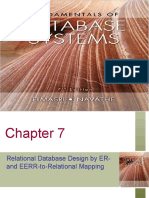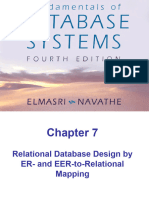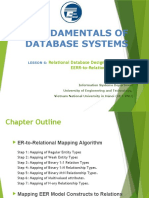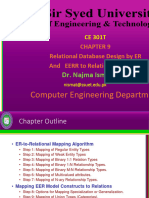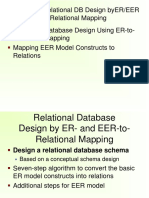0 ratings0% found this document useful (0 votes)
27 viewsModule2 Chapter4
informal guidelines for relational database design
Uploaded by
farha anjumCopyright
© © All Rights Reserved
We take content rights seriously. If you suspect this is your content, claim it here.
Available Formats
Download as PPT, PDF, TXT or read online on Scribd
0 ratings0% found this document useful (0 votes)
27 viewsModule2 Chapter4
informal guidelines for relational database design
Uploaded by
farha anjumCopyright
© © All Rights Reserved
We take content rights seriously. If you suspect this is your content, claim it here.
Available Formats
Download as PPT, PDF, TXT or read online on Scribd
You are on page 1/ 17
Chapter 9
Relational
Database Design
by ER- and
EER-to-
Relational
Mapping
Copyright © 2011 Pearson Education, Inc. Publishing as Pearson Addison-Wesley
Chapter 9 Outline
Relational Database Design Using ER-to-Relational
Mapping
Copyright © 2011 Ramez Elmasri and Shamkant Navathe
Relational Database
Design by ER-to-Relational Mapping
Design a relational database schema
Based on a conceptual schema design
Seven-step algorithm to convert the basic ER model
constructs into relations
Copyright © 2011 Ramez Elmasri and Shamkant Navathe
Copyright © 2011 Ramez Elmasri and Shamkant Navathe
Copyright © 2011 Ramez Elmasri and Shamkant Navathe
ER-to-Relational Mapping Algorithm
Step 1: Mapping of Regular Entity Types
Step 2: Mapping of Weak Entity Types
Step 3: Mapping of Binary 1:1 Relationship Types
Step 4: Mapping of Binary 1:N Relationship Types
Step 5: Mapping of Binary M:N Relationship Types
Step 6: Mapping of Multivalued Attributes
Step 7: Mapping of N-ary Relationship Types
Copyright © 2011 Ramez Elmasri and Shamkant Navathe
ER-to-Relational Mapping Algorithm
COMPANY database example
Assume that the mapping will create tables with simple single-
valued attributes
Step 1: Mapping of Regular Entity Types
For each regular entity type, create a relation R that includes all
the simple attributes of E Called entity relations
• Each tuple represents an entity instance
• Ex: Employee. Department and Project
Copyright © 2011 Ramez Elmasri and Shamkant Navathe
ER-to-Relational Mapping Algorithm
Step 2: Mapping of Weak Entity Types
For each weak entity type, create a relation R and include all
simple attributes of the entity type as attributes of R
Include primary key attribute of owner as foreign key attributes of
R
Ex: Dependent
Copyright © 2011 Ramez Elmasri and Shamkant Navathe
ER-to-Relational Mapping Algorithm
Copyright © 2011 Ramez Elmasri and Shamkant Navathe
ER-to-Relational Mapping Algorithm
Step 3: Mapping of Binary 1:1 Relationship Types
For each binary 1:1 relationship type
• Identify relations that correspond to entity types participating in R
Possible approaches:
• Foreign key approach
• Merged relationship approach
• Cross-reference or relationship relation approach
Copyright © 2011 Ramez Elmasri and Shamkant Navathe
ER-to-Relational Mapping Algorithm
Foreign key approach
Choose one of the relations—S, say—and include as a foreign key in S the primary key
of T. It is better to choose an entity type with total participation in R in the role of S.
Include all the simple attributes (or simple components of composite attributes) of the 1:1
relationship type R as attributes of S.
Ex: Employee – Manages – department (Total Participation)
Merged relationship approach
An alternative mapping of a 1:1 relationship type is to merge the two entity types and the
relationship into a single relation. This is possible when both participations are total
Cross-reference or relationship relation approach
The third option is to set up a third relation R for the purpose of cross-referencing the
primary keys of the two relations S and T representing the entity types.
Copyright © 2011 Ramez Elmasri and Shamkant Navathe
ER-to-Relational Mapping Algorithm
Step 4: Mapping of Binary 1:N Relationship Types
Foreign key approach
For each regular binary 1:N relationship type
• Identify relation that represents participating entity type at N-side of
relationship type
• Include primary key of other entity type as foreign key in S
• Include simple attributes of 1:N relationship type as attributes of S
• To apply this approach to our example, we map the 1:N relationship types
WORKS_FOR, CONTROLS, and SUPERVISION For WORKS_FOR we include the
primary key Dnumber of the DEPARTMENT relation as foreign key in the EMPLOYEE
relation and call it Dno.
Copyright © 2011 Ramez Elmasri and Shamkant Navathe
ER-to-Relational Mapping Algorithm
Step 5: Mapping of Binary M:N Relationship Types
For each binary M:N relationship type
• Create a new relation S
• Include primary key of participating entity types as foreign key attributes
in S
• Include any simple attributes of M:N relationship type
Copyright © 2011 Ramez Elmasri and Shamkant Navathe
ER-to-Relational Mapping Algorithm
Step 6: Mapping of Multivalued Attributes
For each multivalued attribute
• Create a new relation
• Primary key of R is the combination of A and K
• If the multivalued attribute is composite, include its simple components
Copyright © 2011 Ramez Elmasri and Shamkant Navathe
ER-to-Relational Mapping Algorithm
Step 7: Mapping of N-ary Relationship Types
For each n-ary relationship type R
• Create a new relation S to represent R
• Include primary keys of participating entity types as foreign keys
• Include any simple attributes as attributes
Copyright © 2011 Ramez Elmasri and Shamkant Navathe
Discussion and Summary of
Mapping for ER Model
Constructs
Copyright © 2011 Ramez Elmasri and Shamkant Navathe
Summary
Map conceptual schema design in the ER model to a
relational database schema
Algorithm for ER-to-relational mapping
Illustrated by examples from the COMPANY database
Include additional steps in the algorithm for mapping
constructs from EER model into relational model
Copyright © 2011 Ramez Elmasri and Shamkant Navathe
You might also like
- Lecture 7 - Relational Database Design by ER To Relational MappingNo ratings yetLecture 7 - Relational Database Design by ER To Relational Mapping16 pages
- Relational Database Design by ER - To-Relational MappingNo ratings yetRelational Database Design by ER - To-Relational Mapping16 pages
- Presentation 6492 Content Document 20240526121201AMNo ratings yetPresentation 6492 Content Document 20240526121201AM16 pages
- Relational Database Design by ER-MappingNo ratings yetRelational Database Design by ER-Mapping16 pages
- Relational Database Design by ER- and EERR-to-Relational Mapping.pptNo ratings yetRelational Database Design by ER- and EERR-to-Relational Mapping.ppt32 pages
- Week-5 (Section-2 (Part-3 ER Modeling To Relational Mapping) )No ratings yetWeek-5 (Section-2 (Part-3 ER Modeling To Relational Mapping) )30 pages
- Unit 2 Refining The ER, Design For Company DataBase and Relational ModelNo ratings yetUnit 2 Refining The ER, Design For Company DataBase and Relational Model59 pages
- Relational Database Design by Er and Eerr To Relational MappingNo ratings yetRelational Database Design by Er and Eerr To Relational Mapping14 pages
- Unit-2-ER-Relational-Mapping and Relational-ModelNo ratings yetUnit-2-ER-Relational-Mapping and Relational-Model59 pages
- Relational Database Design by ER and EER To Relational MappingNo ratings yetRelational Database Design by ER and EER To Relational Mapping19 pages
- FDS - C9 - Relational Database Design by ER - and EER-to-Relational MappingNo ratings yetFDS - C9 - Relational Database Design by ER - and EER-to-Relational Mapping26 pages
- Outline: - Relational Database Design Using ER-to-Relational Mapping - Mapping EER Model Constructs To Relations0% (1)Outline: - Relational Database Design Using ER-to-Relational Mapping - Mapping EER Model Constructs To Relations22 pages
- ER TO RELATION MAPPING DIAGRAM - 948df672-03c - RM - PDFNo ratings yetER TO RELATION MAPPING DIAGRAM - 948df672-03c - RM - PDF20 pages
- Reduction of ER Model To Relational ModelNo ratings yetReduction of ER Model To Relational Model18 pages
- DBMS - Module2.2 ER To Relational MappingNo ratings yetDBMS - Module2.2 ER To Relational Mapping39 pages
- Chapter 05-2 ER-EER To Relational MappingNo ratings yetChapter 05-2 ER-EER To Relational Mapping27 pages
- UNIT 03-P2 Logical Data Modeling Using The Relational ModelNo ratings yetUNIT 03-P2 Logical Data Modeling Using The Relational Model61 pages
- 01_ER to Relational Model_e723c0e24d95b33f642b34728ed10073No ratings yet01_ER to Relational Model_e723c0e24d95b33f642b34728ed1007314 pages
- Relational Data Base Design - ER To Relational ConversionNo ratings yetRelational Data Base Design - ER To Relational Conversion27 pages
- Operating Systems 19CS541 5 1 10: Course Name: Course Code: Semester: Number of Hours: ContentsNo ratings yetOperating Systems 19CS541 5 1 10: Course Name: Course Code: Semester: Number of Hours: Contents52 pages
- Experiment No - 1: A) B) Construct Appropriate Tables For The Above ER Diagram?No ratings yetExperiment No - 1: A) B) Construct Appropriate Tables For The Above ER Diagram?32 pages
- Designing Databases: Jeffrey A. Hoffer Joey F. George Joseph S. ValacichNo ratings yetDesigning Databases: Jeffrey A. Hoffer Joey F. George Joseph S. Valacich38 pages
- (Barbara Von Halle, Larry Goldberg) The Decision M (BookFi)No ratings yet(Barbara Von Halle, Larry Goldberg) The Decision M (BookFi)556 pages
- Structuring Database For Accounting Class 11 NotesNo ratings yetStructuring Database For Accounting Class 11 Notes38 pages
- Database Systems BS (CS) - 4A, BSSE-3A & 3B Fall-20 Sessional I & II and Their SolutionsNo ratings yetDatabase Systems BS (CS) - 4A, BSSE-3A & 3B Fall-20 Sessional I & II and Their Solutions12 pages



